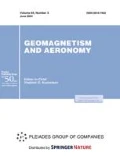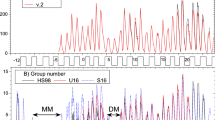Abstract
Data from a long-term experiment with monitoring of the vertical component of the electric field at the base from the surface to the bottom showed oscillations with quasi-periods of tens to hundreds of days in Lake Baikal. They are not caused by any internal sources, but they show a close relationship with intermittent oscillations of the solar X-ray radiation flux. This relationship is characterized by a high (up to 0.9) correlation with a large (multiday) delay. Variations in the electric field are naturally interpreted as a manifestation of the variability of the current in the hydrospheric segment of the global electric circuit over the Baikal Rift. The large delay can be explained by the indirect mechanism of influence in the fluxes of X-ray radiation from the Sun on the convection component of the current in the atmosphere through its complex effect on meteorological processes. In this case, the degree of correlation of X-ray radiation with the electric field is always very high, while the delay in different years can vary by an order of magnitude.



Similar content being viewed by others
REFERENCES
Anisimov, S.V. and Mareev, E.A., Geophysical studies of the global electric circuit, Izv., Phys. Solid Earth, 2008, vol. 44, no. 10, pp. 760–769.
Korotaev, S.M., Gaidash, S.P., Shneer, V.S., Serdyuk, V.O., Budnev, N.M., Mirgazov, R.R., Buzin, V.B., Khalezov, A.A., and Panfilov, A.I., Interannual changeability in the variations of the vertical component of the electric field in Lake Baikal, Izv., Phys. Solid Earth, 2011, vol. 47, no. 2, pp. 147–152.
Korotaev, S.M., Kiktenko, E.O., Gaidash, S.P., Budnev, N.M., Mirgazov, R.R., Panfilov, A.I., Khalezov, A.A., Serdyuk, V.O., and Shneer, V.S., Relationship between variations in the electric field’s vertical component in Lake Baikal and solar activity, Geomagn. Aeron. (Engl. Transl.), 2013, vol. 53, no. 6, pp. 769–773.
Korotaev, S.M., Budnev, N.M., Serdyuk, V.O., Zurba-nov, V.L., Mirgazov, R.R., Machinin, V.A., Kiktenko, E.O., Buzin, V.B., Novysh, A.V., and Portyan-skaya, I.A., Results of vertical electric field monitoring in Lake Baikal, Izv., Phys. Solid Earth, 2015a, vol. 51, no. 4, pp. 602–610.
Korotaev, S.M., Budnev, N.M., Serdyuk, V.O., Zurbanov, V.L., Mirgazov, R.R., Machinin, V.A., Kiktenko, E.O., Buzin, V.B., and Panfilov, A.I., Recent results of monitoring of the vertical component of the electrical field in Lake Baikal on the surface–bed baseline, Geomagn. Aeron. (Engl. Transl.), 2015b, vol. 55, no. 3, pp. 398–409.
Korotaev, S.M., Budnev, N.M., Serdyuk, V.O., Kiktenko, E.O., and Gorokhov, Yu.V., Deepwater electromagnetic monitoring in Lake Baikal: Classical and nonclassical aspects, Vopr. Estestvozn., 2016, no. 2, pp. 41–53.
Korotaev, S.M., Budnev, N.M., Serdyuk, V.O., Orekhova, D.A., Kruglyakov, M.S., Kiktenko, E.O., Mirgazov, R.R., Zurbanov, V.L., Gorokhov, Yu.V., and Ryabov, E.V., Baikal electromagnetic experiment, Izv., Atmos. Ocean. Phys., 2018a, vol. 54, no. 11, pp. 1569–1594.
Korotaev, S.M., Serdyuk, V.O., and Budnev, N.M., Correlation between long-term variations in the vertical component of the electric field in Baikal and solar activity, Geomagn. Aeron. (Engl. Transl.), 2018b, vol. 58, no. 1, pp. 142–145.
Kumar, C.P.A., Panneerselvavam, C., Nair, K.U., Jeeva, K., Selvaraj, C., Jeyakumar, H.J., and Gurubaran, S., Measurement of atmospheric air–earth current density from a tropical station using improvised Wilson’s plate antenna, Earth Planets Space, 2009, vol. 61, pp. 919–926.
Kuznetsova, T.V., Tsirul’nik, L.B., and Petrov, V.G., Changes in the interplanetary magnetic field during different time intervals according to space-age measurements, Izv. Ross. Akad. Nauk, Ser. Fiz., 2000, vol. 64, no. 9, pp. 1880–1886.
Lean, J.L. and Brueckner, G.E., Intermediate-term solar periodicities: 100–500 days, Astrophys. J., 1989, vol. 337, pp. 568–578.
Moldavanov, A.V., Stratospheric discharges during solar gamma flares, J. Phys. D: Appl. Phys., 2003, vol. 36, pp. L1–L4.
Morgunov, V.A., Spatial inhomogeneities of the atmospheric electric field as a factor of lithospheric–ionospheric coupling, in Elektricheskoe vzaimodeistvie geosfernykh obolochek (Electric Interaction of Geospheric Shells), Moscow: OIFZ, 2000, pp. 106–113.
Morozov, V.N., Shvarts, Ya.M., and Shchukin, G.G., The global electric circuit: Physical and mathematical simulation and regular measurements in the lower atmosphere, in Elektricheskoe vzaimodeistvie geosfernykh obolochek (Electric Interaction of Geospheric Shells), Moscow: Ob”ed. Inst. Fiz. Zemli, Ross. Akad. Nauk, 2000, pp. 55–67.
Pankratov, O.V., Kuvshinov, A.V., and Avdeev, A.B., Ez-response, as a monitor of Baikal rift fault electrical resistivity: 3-D-modeling studies, Ann. Geophys., 2004, vol. 47, no. 1, pp. 151–156.
Panneerselvavam, C., Kumar, C.P.A., Nair, K.U., Selvaraj, C., Gurubaran, S., and Pathan, B.M., Instrumentation for the surface measurements of atmospheric electrical parameters at Maitri, Antarctica: First results, Earth Planets Space, 2010, vol. 62, pp. 545–549.
Pulinets, S.A., Ouzunov, D.P., Karelin, A.V., Boyarchuk, K.A., Tertyshnikov, A.V., and Yudin, Yu.A., Unified conception of indicators for strong earthquake preparation in the complex lithosphere–atmosphere–ionosphere–magnetosphere system, Geliogeofiz. Issled., 2013, no. 6, pp. 81–90.
Pulinets, S.A., Ouzunov, D.P., Karelin, A.V., and Davidenko, D.V., Physical bases of the generation of short-term earthquake precursors: A complex model of ionization-induced geophysical processes in the lithosphere–atmosphere–ionosphere–magnetosphere system, Geomagn. Aeron. (Engl. Transl.), 2015, vol. 55, no. 4, pp. 521–538.
Rieger, E., Share, G.H., and Forrest, D.G., A 154 day periodicity in the occurrence of hard flares, Nature, 1984, vol. 312, pp. 625–627.
Sanford, T.B., Motionally induced electric and magnetic fields in the sea, J. Geophys. Res., 1971, vol. 76, pp. 3476–3492.
Shneer, V.S., Gaidash, S.P., Trofimov, I.L., Korotaev, S.M., Kuznetsova, T.V., Tsirul’nik, L.B., Panfilov, A.I., Budnev, N.M., and Mirgazov, R.R., Long-term observations of the electric field vertical component in Lake Baikal (preliminary results), Izv., Phys. Solid Earth, 2007, vol. 43, no. 4, pp. 331–335.
Funding
This study was financially supported by the Russian Foundation for Basic Research (project no. 20-05-00001).
Author information
Authors and Affiliations
Corresponding author
Rights and permissions
About this article
Cite this article
Korotaev, S.M., Budnev, N.M., Serdyuk, V.O. et al. Manifestation of Variations of Solar X-Ray Radiation in the Vertical Component of the Electric Field in Lake Baikal. Geomagn. Aeron. 61, 215–221 (2021). https://doi.org/10.1134/S0016793221020079
Received:
Revised:
Accepted:
Published:
Issue Date:
DOI: https://doi.org/10.1134/S0016793221020079




